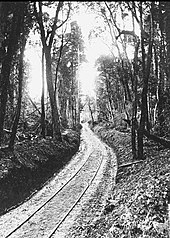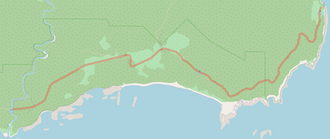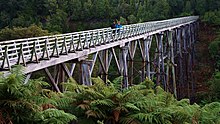Port Craig Tramway
| Port Craig Tramway | |||||||||||||||||||||||||
|---|---|---|---|---|---|---|---|---|---|---|---|---|---|---|---|---|---|---|---|---|---|---|---|---|---|
|
The locomotive Ar No. 115 by A. & G. Price
| |||||||||||||||||||||||||
|
Today's hiking trail along the old route
| |||||||||||||||||||||||||
| Route length: | 14.6 km + 9.8 km | ||||||||||||||||||||||||
| Gauge : | 1067 mm ( cape track ) | ||||||||||||||||||||||||
| Maximum slope : | 33 ‰ | ||||||||||||||||||||||||
|
|||||||||||||||||||||||||
The Port Craig Tramway was a total of 15.4 kilometers long, operated from 1917 to 1928, private forest railway with a gauge of 1067 mm (3 feet 6 inches ) at Port Craig in New Zealand .
location

The 14.6 km long main line ran from Port Craig in a southerly direction parallel to the coast to the Wairaurahiri River . There were also a total of 9.8 km long branches. With a maximum gradient of 33 ‰ (1 in 29.5) and deep cuts and high bridges, the main line was built much more elaborately than comparable forest railways.
There were four large wooden viaducts built around 1925. The Percy Burn Viaduct is 125 m long and 36 m high and was designed for the transport of the 80-tonne Lidgerwood steam cable winch imported from America and for loaded log trains. Australian hardwood was used in the construction, among other things, because it is stronger and more durable than native woods from New Zealand. The pillars of the Sand Hill Viaduct consist of round hardwood trunks, with the less durable sapwood also being built in. The other viaducts are all made of sawn squared timber from which the sapwood has been removed.
The four viaducts are the largest surviving forest railway viaducts in New Zealand. They are under monument protection and are in need of renovation.
history
construction

Construction of the forest railway began in 1917. In 1921 it was more than 1.5 km long and was extended in 1925.
The screws for the wooden bridges were made on site in the Port Craig forge. Every morning the blacksmith made a lot of 200 bolts from round bars twice as long by forging a head on both sides. These were then split in two with a sledge hammer and a cold chisel. The teacher from the factory school in the camp came to the forge in the afternoons after class to cut the threads. The quality standards were high: every bolt that was more than 1 inch (25 mm) too long was claimed.
The Sand Hill Viaduct started operating around 1924. The larger Percy Burn Viaduct was completed around 1925, after which the Chester Construction Company went bankrupt. The third and fourth viaducts were probably put into operation by 1926 at the latest. The Sand Hill, Edwin Burn and Francis Burn Viaducts were built by Jim Kane, a former bridge builder for NZ Railways, and a team of company employees.
The Lidgerwood steam cable winch was taken out of service in 1926 due to a technical failure of the boiler. From 1928 the company was no longer solvent and the sawmill was closed. It was briefly revived in 1930, but the settlement was largely demolished in the late 1930s. The rails were dismantled in 1939.
business
The nearby forest areas on Maori land were one of the most important locational advantages, as negotiations with their native owners made it possible to circumvent the restrictions on the state forest. The Maori land, the trees of which the Marlborough Timber Company (MTC) was aiming for , had been assigned to the Maori under the South Island Landless Natives Act 1906, but they had little chance of making a living with it. Most Maori were therefore willing to cede the clearing rights for 4,000 acres. Only the owners of two sections between Mussel Beach and the Wairaurahiri River refused to sell the clearing rights to the sawmill operation. The Ministry of Forestry demanded that the price paid to Maori owners be at the usual rate for state forest licenses, not only to protect the interests of these owners, but also to ensure that the value of the surrounding state forest is not compromised will.
closure
The forest was less productive than expected, the American steam cable winch was oversized for the New Zealand bush and shipping was expensive because the port quickly silted up behind the newly constructed pier. As a result of the unforeseen decline in demand for wood, wood prices fell, so that the operation became unprofitable and the high capital investments were not worthwhile in retrospect.
In late 1928, the company's directors finally decided to resign and the operation was immediately closed with minimal notice. Shortly thereafter, Sims Cooper, who had invested heavily in the operation, formed Holdings Limited to take over the liquidated assets of MTC. Holdings Limited employed some staff to protect the on-site assets and was able to take over the logging and rail operating licenses originally held by MTC in the hopes that it could resume operations and cover some of the investments. In the months before, the MTC had applied for a new license area in the state forest north of Maori land at the Percy Burn Viaduct, when it became apparent that it was impossible to raise the capital for a bridge on the Wairaurahiri River, so this was the last option was to get new forest. Holdings Limited also took over the licenses for this area and maintained them from 1928 to 1941. In 1930 there was a brief revival of the sawmill business, but this was doomed to failure due to the effects of the global economic crisis on wood prices. In 1938 a team was sent to recover as much as possible and tear down the rest. As a result, the Forestry Office rejected the last license extension application in 1941, so that the license rights expired.
Locomotives
The railway line was operated with steam locomotives from 1919.
A. & G. Price's Ar No. 115 locomotive was operated by the Marlborough Timber Co. in Port Price from 1926 to 1931. It was of the Meyer type with a 0-4-0 + 0-4-0 wheel arrangement . It was the largest and heaviest locomotive Price built.
The smaller saddle tank locomotive No. 28 was also used. It was a Davenport with the factory number 1862 from 1921. Its PWD number with the Department of Public Works was 528. It was sold in 1935 to Bruce Bay Timber.
Hiking trails
Parts of the right-of-way of the route were made accessible again in 2009 as the Hump Ridge Track and South Coast Track . The former school has been used as an overnight hut since then.
Web links
Individual evidence
- ^ Historic Port Craig Sawmill and Settlement Site . Retrieved June 23, 2018.
- ↑ a b c d e f g Rachael E Egerton: Heritage Management at the Port Craig Sawmill Complex: Successes and Challenges. In: 3rd Australasian Engineering Heritage Conference 2009. ( Memento from May 22, 2010 in the Internet Archive )
- ^ A b c Warren Bird: Viaducts Against the Sky. The Story of Port Craig.
- ↑ a b Trevor Butler: Please enter either wayback - or webciteID - or archive-is - or archiv-url parameters
- ^ Port Craig. (Otago Daily Times, 1921-09-29) . Retrieved June 23, 2018.
- ↑ News in letter. (Otago Daily Times, 1924-07-31) . Retrieved June 23, 2018.
- ^ Port Craig Sawmill and Settlement . Retrieved June 23, 2018.
- ^ News of the Day. (Auckland Star, 1939-03-21) . Retrieved June 23, 2018.
- ↑ Value of homining pidgeons (Evening Star, 1919-03-21) . Retrieved June 23, 2018.
- ^ A & G Price Ltd. - Page 2. New Zealand Geared Locomotives.
- ^ Davenport # 1862 of 1921. In: New Zealand Rolling Stock Register.
Coordinates: 46 ° 14 ′ 27.9 ″ S , 167 ° 18 ′ 14.2 ″ O








